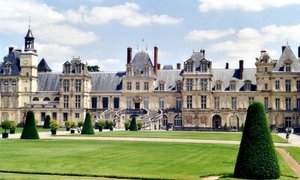|
|
The Royal Château of Fontainebleau (in the Seine-et-Marne département), the largest of the French royal châteaux, introduced to France the Italian Mannerist style in interior decoration and in gardens, and transformed them in the translation. The French Mannerist style of interior decoration of the 16th century is known as the "Fontainebleau style:" it combined sculpture, metalwork, painting, stucco and woodwork, and outdoors the patterned garden parterre. The Fontainebleau style combined allegorical paintings in molded plasterwork where the framing was treated as if it were leather or paper, slashed and rolled into scrolls and combined with arabesques and grotesques. Fontainbleau ideals of female beauty are Mannerist: a small neat head on a long neck, exaggeratedly long torso and limbs, small high breasts — almost a return to Late Gothic beauties. The new works at Fontainebleau were recorded in refined and detailed engravings that circulated among connoisseurs and artists. Through the engravings by the "Fontainebleau school" this new style was transmitted to other northern European centers, Antwerp especially, and Germany, and eventually London. The château as it is today is the work of many monarchs, building on a structure of François I. The building is ranged round a series of courts.
The city of Fontainebleau has grown up around the remainder of the "Forest of Fontainebleau," a former royal hunting park.
The older château on this site was already used in the latter part of the 12th century by Louis VII, for whom Thomas à Becket consecrated the chapel. Fontainebleau was a favourite residence of Philip Augustus and Louis IX. The creator of the present edifice was François I, under whom the architect Gilles le Breton erected most of the buildings of the Cour Ovale, including the Porte Dorée, its southern entrance. The king also invited the architect Sebastiano Serlio to France, and Leonardo da Vinci.
The "Gallery of Francis I", with its frescoes framed in stucco by Rosso Fiorentino between 1522 and 1540, was the first great decorated gallery built in France. Broadly speaking, at Fontainebleau the Renaissance was introduced to France. The Salle des Fêtes, in the reign of Henri II, was decorated by the Italian Mannerist painters, Francesco Primaticcio and Niccolo dell’ Abbate. Benvenuto Cellini's "Nymph of Fontainebleau," commissioned for the château, is at the Louvre.
Another campaign of extensive construction was undertaken by King Henri II and Catherine de' Medici, who commissioned architects Philibert Delorme and Jean Bullant.
To the Fontainebleau of François I and Henri II, King Henri IV added the Court that carries his name, the Cour des Princes, with the adjoining Galerie de Diane de Poitiers and the Galerie des Cerfs, used as a library. A "second school of Fontainebleau" decorators, less ambitious and original than the first, evolved from these additional projects. Henri IV pierced the wooded park with a 1200m canal (which can be fished today) and ordered the planting of pines, elms and fruit trees.
Napochatfontbleuthrrm.jpg
Three hundred years later the château had fallen into disrepair and during the French Revolution many of the original furnishings were stolen. What remained were sold, in the long Revolutionary sales of the contents of all the Royal châteaux, intended as a way of raising money for the nation and insuring that the Bourbons could not return to their comforts. Nevertheless, with a decade Emperor Napoleon Bonaparte, began to transform the Château de Fontainebleau into a symbol of his grandeur, as an alternative to empty Versailles, with its Bourbon connotations. At Fontainebleau Napoleon bade farewell to his Old Guard and went into exile in 1814. With modifications of the château's structure, including the cobblestone entrance wide enough for his carriage, Napoleon helped make the château the place that visitors see today. Fontainebleau was the setting of the Second Empire court of his nephew Napoleon III.
Philip the Fair, Henry III and Louis XIII were all born in the palace, and the first of these kings died there. Christina of Sweden lived there for years, following her abdication in 1654. In 1685 Fontainebleau saw the signing of the Edict of Fontainebleau, which revoked the Edict of Nantes (1598). Royal guests of the Bourbon kings were housed at Fontainebleau: Peter the Great of Russia and Christian VII of Denmark, and so, under Napoleon was Pope Pius VII — in 1804 when he came to consecrate the emperor Napoleon, and in 1812—1814, when he was Napoleon's prisoner.

